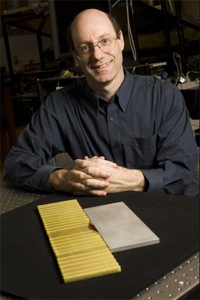David Smith Discusses the Science of Invisibility
Professor David R. Smith answers viewer questions Thursday about his work on metamaterials and "invisibility cloak" prototype
Haiyan Gao, chair of Duke's physics department. answers viewer questions
March 15 about her work involving neutrons, quarks and the search for a
new fundamental force of nature.Haiyan Gao, chair of Duke's physics department. answers viewer questions
March 15 about her work involving neutrons, quarks and the search for a
new fundamental force of nature.Haiyan Gao, chair of Duke's physics department. answers viewer questions
March 15 about her work involving neutrons, quarks and the search for a
new fundamental force of nature.Haiyan Gao, chair of Duke's physics department. answers viewer questions
March 15 about her work involving neutrons, quarks and the search for a
new fundamental force of nature.

Harry Potter and numerous sci-fi novels have glamorized the idea of a cloak of invisibility, but Duke engineering professor David R. Smith has come up with a blueprint for the real thing. His research on a prototype cloak was selected as one of the top-ten scientific breakthroughs of the year in 2006 by Science Magazine. In a live, "Office Hours" webcast interview Feb. 23, Smith answers viewers' questions on the science of invisibility.
"When you think of cloaking invisibility, you think of making something vanish," Smith said about the prototype cloaking device he and his colleagues developed. "Right now, we don't know how to do that. This is just a simple example where you can take one wavelength of one color and you can cheat cloaking of that color."
Watch the webcast live Thursday beginning at noon on the Duke University Ustream channel. To pose a question for Smith, email live@duke.edu, post to the Duke University Facebook page or Tweet with the hashtag #dukelive.
Smith's research focuses on composite materials called metamaterials and how to engineer them to have desired properties such as the cloaking ability. In other experiments, he and his colleagues have investigated how metamaterials can conceal sound and reduce drag on objects moving in air or water.
Watch the NOVA segment on Smith's research.
Smith is the William Bevan Professor of Electrical and Computer Engineering at Duke's Pratt School of Engineering and director of the school's Center for Metamaterials and Integrated Plasmonics. He was named one of Scientific American's top-50-researchers in 2006. His discoveries have been featured in The New York Times, The Wall Street Journal, CNBC, The Today Show, NOVA and many other news outlets.

Duke "Office Hours" webcast series allows members of the Duke community and others to engage in live conversations with faculty about their research and scholarship. Visit the Office Hours website to see a schedule of upcoming topics, watch past episodes and sign up for email reminders.